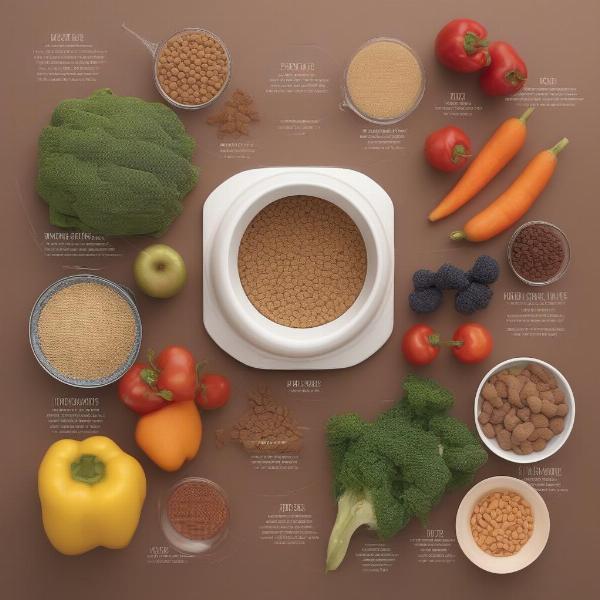Fiber plays a crucial role in maintaining a dog’s digestive health. Just like in humans, fiber can help regulate bowel movements, prevent constipation and diarrhea, and even contribute to overall well-being. Whether your furry friend suffers from digestive issues or you’re simply looking to improve their diet, understanding the benefits and sources of pro fiber for dogs is essential.
Understanding the Importance of Fiber in a Dog’s Diet
Fiber is a type of carbohydrate that isn’t digested by the body. Instead, it passes through the digestive system, providing bulk to the stool and promoting regular bowel movements. For dogs experiencing constipation, fiber can soften the stool and make it easier to pass. Conversely, for dogs with diarrhea, fiber can absorb excess water and help firm up the stool. Beyond these benefits, fiber can also aid in weight management by promoting satiety and regulating blood sugar levels. It also plays a role in maintaining a healthy gut microbiome, which is essential for overall health.
Different Types of Fiber for Dogs
There are two main types of fiber: soluble and insoluble. Soluble fiber dissolves in water, forming a gel-like substance in the digestive tract. This type of fiber can help regulate blood sugar levels and lower cholesterol. Insoluble fiber, on the other hand, does not dissolve in water and adds bulk to the stool. This promotes regular bowel movements and can help prevent constipation. Both types of fiber are important for a dog’s digestive health, and a balanced diet should include both.
Best Sources of Pro Fiber for Dogs
Several readily available foods can provide your dog with the necessary fiber. Fruits and vegetables like pumpkin, sweet potatoes, carrots, and apples (without seeds or core) are excellent sources of fiber. Whole grains like brown rice and oats can also contribute to a dog’s fiber intake. Additionally, commercial dog foods specifically formulated for digestive health often contain added fiber. high protein dog food may also contain added fiber for better digestion.
 Fiber-Rich Dog Food
Fiber-Rich Dog Food
How Much Fiber Does My Dog Need?
The amount of fiber a dog needs depends on factors such as age, size, breed, and overall health. It’s best to consult with a veterinarian to determine the appropriate amount of fiber for your dog’s individual needs. Too much fiber can lead to gas, bloating, and even diarrhea, while too little can cause constipation. Your vet can help you find the right balance.
Signs Your Dog Needs More Fiber
Is your dog experiencing irregular bowel movements? Changes in stool consistency, such as very hard or very loose stools, can be a sign of inadequate fiber intake. Straining during bowel movements is another indicator. If your dog is exhibiting any of these symptoms, it’s a good idea to talk to your vet about increasing their fiber intake. best kibble for dogs with sensitive stomachs can be a good option if your dog has digestive sensitivities.
Adding Fiber to Your Dog’s Diet Gradually
When increasing your dog’s fiber intake, it’s important to do so gradually. Sudden changes in diet can upset the digestive system. Start by adding small amounts of fiber-rich foods to their meals and monitor their stool. Gradually increase the amount until you achieve the desired consistency. Remember, consistency is key.
Conclusion: Prioritizing Your Dog’s Digestive Health with Fiber
Pro fiber plays a vital role in maintaining a dog’s digestive health, contributing to regular bowel movements, and overall well-being. By understanding the benefits and sources of fiber, you can help your furry companion live a healthier, more comfortable life. Remember to consult with your veterinarian to determine the right amount of fiber for your dog’s specific needs.
FAQs
- What are the signs of fiber deficiency in dogs? Constipation, straining during bowel movements, and changes in stool consistency.
- Can I give my dog human fiber supplements? No, it’s best to use dog-specific fiber supplements recommended by your vet.
- What are some easy ways to add fiber to my dog’s food? Adding cooked pumpkin, sweet potato, or carrots to their meals.
- Is too much fiber bad for dogs? Yes, too much fiber can lead to gas, bloating, and diarrhea.
- What if my dog doesn’t like fiber-rich foods? Try mixing the fiber source with a small amount of their favorite food.
- Can fiber help with my dog’s weight management? Yes, fiber can help dogs feel full, reducing their overall calorie intake.
- How long does it take to see results after adding fiber to my dog’s diet? You might see improvements in a few days, but it can take a couple of weeks for optimal results.
About ILM Dog
ILM Dog is your go-to resource for expert advice on dog care, offering guidance on breed selection, health and medical care, training, nutrition, grooming, exercise, and much more. Whether you’re a new dog owner or a seasoned pro, our comprehensive resources are designed to help you provide the best possible care for your furry friend. We specialize in providing tailored advice for dog owners across the globe, taking into consideration various cultural nuances and individual dog needs. From choosing the right couch protectors for dogs to understanding if can dogs eat bulgur wheat, we cover all aspects of dog ownership. Contact us today via email at [email protected] or phone at +44 20-3965-8624 for personalized advice.